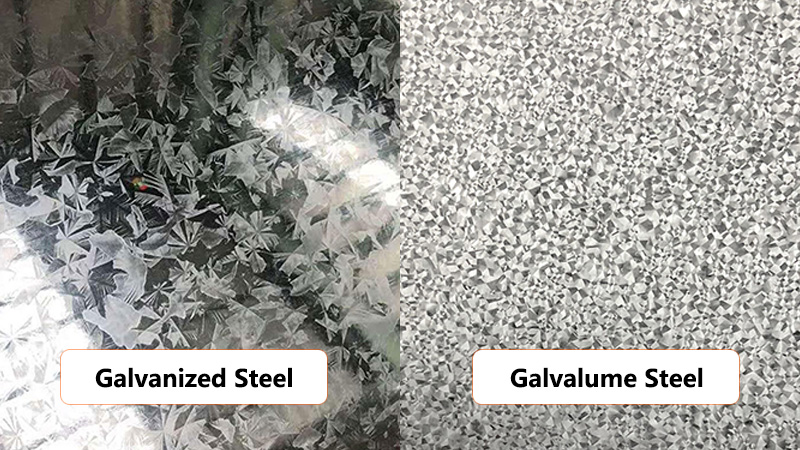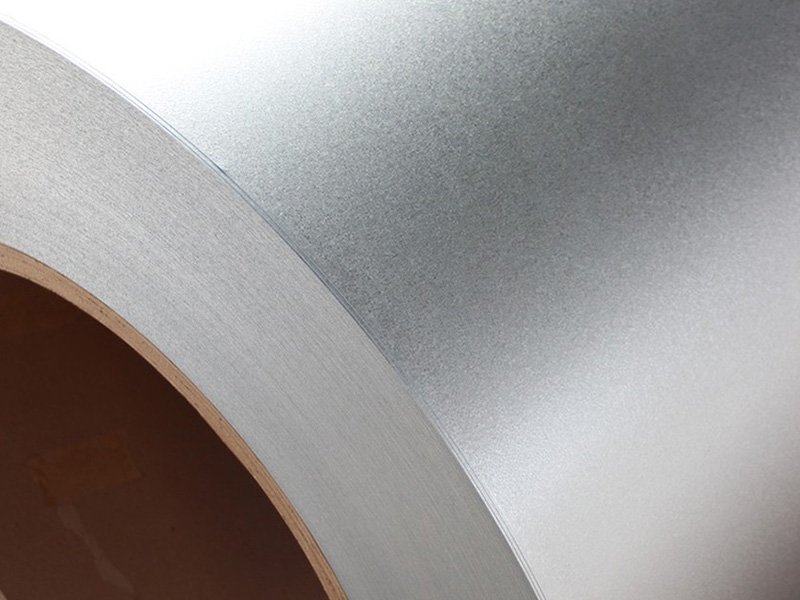Galvanized steel (GI) and aluminum zinc coated steel (GL, Galvalume or Galvalume Steel, typically coated with 55% aluminum, 43.4% zinc, and 1.6% silicon alloy) exhibit significant differences in performance in high-temperature environments, and their advantages and disadvantages also vary depending on the application scenario. The following is a detailed comparison and analysis:
1. High temperature resistance
Galvanized steel plate:
The melting point of zinc is 419 ° C, which accelerates oxidation at high temperatures (over 200 ° C), causing the coating to easily peel off or produce white zinc oxide, losing its protective effect. When exposed to an environment above 300 ° C for a long time, the galvanized layer may completely fail, leading to substrate corrosion.
Aluminum zinc coated steel plate:
The melting point of aluminum is 660 ° C, and aluminum forms a dense aluminum oxide (Al ₂ O3) protective layer at high temperatures, with significantly better high temperature resistance than galvanized steel plates. It can withstand high temperatures below 600 ° C for a long time (up to 800 ° C in the short term) and is suitable for high-temperature environments such as chimneys, ovens, roofs, etc.
2. Heat reflectivity:
The aluminum coating of aluminum zinc coated steel plate has a higher thermal reflectivity (about 80%, while that of galvanized steel plate is 30-40%), which can reduce heat absorption and lower the substrate temperature in high temperature environments.
3. Coating oxidation rate:
Galvanized steel plates are prone to electrochemical corrosion (such as "white rust") in high temperature and high humidity environments; Aluminum zinc coated steel plates have a slower oxidation rate due to the inertness of aluminum.
 4.Advantages of galvanized steel sheet
4.Advantages of galvanized steel sheet
Low cost: The galvanizing process is mature, and the price is usually lower than that of aluminum zinc coated steel plates.
Good processability: The zinc layer is relatively soft, easy to press, bend and other processes, and not prone to cracking.
Cathodic protection: Zinc has a stronger sacrificial anodic protection effect on steel substrates, and can still delay substrate corrosion when the coating is damaged (especially suitable for humid environments).
Welding performance: The galvanized layer has a smaller impact on welding and the welding process is simpler.
5.Advantages of aluminum zinc coated steel plate
High temperature resistance: suitable for long-term exposure to high temperatures (such as industrial furnaces, automotive exhaust pipes).
Corrosion resistance: The ability of aluminum coating to resist atmospheric corrosion (especially in salt and acid rain environments) is 2-6 times that of galvanized coating. The aluminum oxide layer can prevent further corrosion.
Heat reflectivity: reduces the heat load on building roofs, solar equipment, etc.
Lightweight: Under the same corrosion resistance, aluminum zinc coated steel plates can use thinner coatings.
Long lifespan: In most environments, the service life is more than 50% longer than galvanized sheet.
6.Applicable scenarios for galvanized steel plates:
Low temperature (<200 ° C), high humidity environment (such as indoor pipelines, ordinary color steel plates).
Projects that require frequent processing or low cost, such as home appliance casings and ordinary building materials.
7.Applicable scenarios for aluminum zinc coated steel plates:
High temperature and highly corrosive environments (such as industrial plant roofs, chimneys, and car exhaust systems).
Scenarios that require long lifespan and thermal reflection, such as solar brackets and coastal buildings.
8.Precautions
Limitations of aluminum zinc coated steel plate:
Aluminum coating has high hardness and is prone to cracking during processing (requiring specialized tools and techniques).
The cut and damaged areas need to be coated with protective paint, otherwise "cut corrosion" may occur.
Limitations of galvanized steel sheet:
Avoid use in long-term high-temperature environments, otherwise additional high-temperature resistant coatings need to be sprayed.
At Last
In high temperature environments, aluminum zinc coated steel plates outperform galvanized steel plates due to the heat resistance and oxidation resistance of aluminum; Galvanized steel plates have more advantages in terms of processability and cost. Choose comprehensively based on specific temperature, corrosion conditions, and budget.



 4.Advantages of galvanized steel sheet
4.Advantages of galvanized steel sheet
 English
English